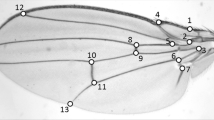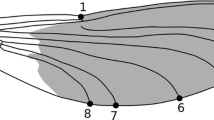Abstract
Several species ofCardiocondyla ants have dimorphic males: wingless (ergatoid) and winged (alate) males, while otherCardiocondyla species includingC. nuda have only wingless males. We made an evolutionarily stable strategy model for explaning the male polymorphism and the ratios of wingless males in the genusCardiocondyla. Wingless males emerge earlier than winged males in each reproductive season. Females (F 1) which have emerged before winged males copulate only with wingless males, and females (F 2) which emerge after winged males copulate with both wingless and winged males. Wingless males have a lower copulation ability (b n) than winged males (b w). The reproductive success of females which copulate at the early stage (v 1) is assumed to be larger than that of females which copulate at the late stage (v 2). The model predicts that there are 3 different evolutionarily stable states: 2 monomorphic states of wingless and winged males, and a dimorphism of the 2 types of males. In the dimorphic state, the rate of wingless males increases as the survival rate of wingless males (s) increases,v 1/v 2 increases,F 1/F 2 increases andb n/b w increases. For dimorphism to exist,s b n/b w<1 must be satisfied, and this condition corresponds to the value of observed data. The value ofv 1/v 2 would be difficult to be obtained by actual data, but we can estimate this value with the model.
Similar content being viewed by others
References
Higashi, M. & N. Yamamura 1993 What determines the animal group size: insider-outsider conflict and its resolution.Am. Nat (in press)
Kinomura, K. & K. Yamauchi 1987 Fighting and mating behaviors of dimorphic males in the antCardiocondyla wroughtonii.J. Ethol. 5: 75–81.
Maynard Smith, J. 1982 Evolution and the Theory of Games. Cambridge Univ. Press, Cambridge.
Roff, D.A. 1986 The evolution of wing dimorphism in insects.Evolution, 40: 1009–1020.
Stuart, R.J., A. Francoeur & R. Loiselle 1987 Lethal fighting among dimorphic males of the ant,Cardiocondyla wroughtonii.Naturwissenschaften 74: 548–549.
Yamamura, N. 1986 A model on correlation between precopulatory guarding and short receptive to copulation.J. theor. Biol. 127: 171–180.
Yamamura, N. 1986 Mathematical Models of Reproductive Strategies. Tokai Univ. Press, Tokyo. (in Japanese)
Yamamura, N. & N. Tsuji 1989 Postcopulatory guarding strategy in a finite mating period.Theor. Popul. Biol. 35: 36–50.
Yamauchi, K. & K. Kinomura 1993 Lethal fighting and reproductive strategies of dimorphic males inCardiocondyla ants (Hymenoptera: Formicidae) In: T. Inoue & S. Yamane (eds.)Evolution of Insects Societies. pp. 373–402. Hakuhin-sya, Tokyo. (in Japanese)
Yamauchi, K. & N. Kawase 1992 Phoromonal manipulation of workers by a fighting male to kill his rival in the antCardiocondyla wroughtonii.Naturwissenschaften 79: 274–276.
Author information
Authors and Affiliations
About this article
Cite this article
Tsuji, N., Yamauchi, K. & Yamamura, N. A mathematical model for wing dimorphism in maleCardiocondyla ants. J. Ethol. 12, 19–24 (1994). https://doi.org/10.1007/BF02350076
Received:
Accepted:
Issue Date:
DOI: https://doi.org/10.1007/BF02350076




